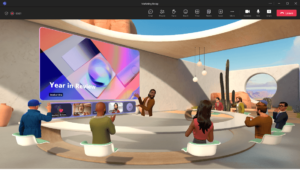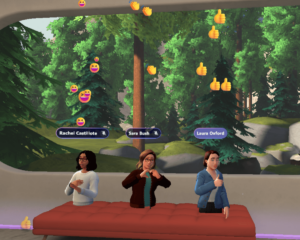 Several years into the era of hybrid work, most of us are used to appearing in a Brady Bunch-style gallery. We select an emoji to ask a question or applaud an achievement and still have to remember “unmute” when it’s our turn to talk.
Several years into the era of hybrid work, most of us are used to appearing in a Brady Bunch-style gallery. We select an emoji to ask a question or applaud an achievement and still have to remember “unmute” when it’s our turn to talk.
Half of workers have gone back to the office, but much of our collaboration with others is still being done in online meetings. Clearly, the hybrid workplace isn’t going anywhere. Many organizations have tried hard to figure out a structure to accommodate their employees from wherever they dial in—whether it is executive boardroom or their back porch. But it’s a big jump from diagnosing the challenges to devising solutions that enable people to connect more deeply in online meetings.
There’s no doubt that we’re a hybrid company here at Microsoft. Our colleagues are more distributed and diverse than ever before. This is why we built Microsoft Mesh, a 3D immersive space built into Microsoft Teams. Teammates show up as avatars and interact with one another in real time in the same virtual space.

Introducing Microsoft Mesh
Microsoft Mesh is a platform that powers shared immersive experiences, connecting people in a more natural way. Here’s how it can help you:
- Foster copresence: In a world of flexible work, Mesh enables copresence, allowing people to feel connected even when physically apart.
- Seamless integration: You can use Mesh seamlessly within Teams meetings or as a standalone app for hosting larger, custom experiences.
- Immersive spaces: Experience avatars and immersive spaces in Teams meetings, fostering a powerful sense of togetherness.
- Custom experiences: Tailor immersive experiences to your business needs, such as employee events, trainings, tours, or internal product showcases.
- Security and familiar devices: Enjoy comprehensive security while using familiar devices.
We wanted to get immersive spaces right for ourselves here at Microsoft and for thousands of organizations that need flexible hybrid solutions. And in effort to solve complex challenges with nuanced technical solutions, we have had to learn along the way.
One way we do this is by receiving and incorporating feedback from our own employees before we release products to the public, a concept we call Customer Zero. Immersive spaces benefited greatly from this cycle of refinement.
[Discover what we learned about avatar etiquette. Get the story on our role as the company’s Customer Zero.]
Collaborating beyond the grid

“The future of distributed collaboration is more than the video grid,” says Jeff Teper, president of Microsoft 365 Collaborative Apps and Platforms, who shared his view in a LinkedIn post announcing the public preview of Mesh.
“(Mesh) is a step forward for us all to learn together,” Teper says.
Immersive spaces allows participants to connect more naturally. You can bond with coworkers as you toss bean bags, sit by the firepit, or gather on couches in a lake house—all within Teams accessible via PC or VR headset.
Hybrid work is now the norm, with people from the same team working remote from many different locations. We’re no longer having those authentic moments during or in-between working sessions to socialize and create personal connection at work.”
—Alexandre Godin, principal product manager, Microsoft Mesh product team
Mixed reality products had been brewing for years with products like HoloLens, but the pandemic massively accelerated this work.
“Hybrid work is now the norm, with people from the same team working remote from many different locations,” says Alexandre Godin, a principal product manager who helped build Microsoft Mesh from its inception. “We’re no longer having those authentic moments during or in-between working sessions to socialize and create personal connection at work.”
The geo-diversity of our teams has made finding connection on our Teams calls as important as it’s ever been. Immersive spaces fills that void and enables teammates to easily and more naturally interact with each other virtually.
“It feels like I don’t need to wait for my turn to have a conversation,” Godin says. “You get to interact in a much more natural way with a sense of physical togetherness in this 3D space.”
For the first time, it’s really easy to use and is accessible to everyone in Teams. I’m not here and you’re there; we are all here together in virtual reality.
—Sara Bush, principal product manager, Microsoft Digital
It’s creating a new way to communicate.
“For the first time, it’s really easy to use and is accessible to everyone in Teams,” says Sara Bush, a principal product manager for the team in Microsoft Digital, the company’s IT organization. “I’m not here and you’re there; we are all here together in virtual reality.”
Impressive spatial audio

Everyone who has tried immersive spaces agrees that this virtual world’s coolest feature and biggest brain-bender is spatial audio.
“As you could in reality, you can move away from the cluster of folks you’re talking to, or the main meeting environment, and the audio will reflect that,” says Bush, an 11-year Microsoft veteran who helped deploy Teams across Microsoft in 2018.
“You’ll get a visual notification on your screen, and you will notice the audio fade out and you can no longer hear those people that you were standing with,” she says. “But now you can hear this other group that you’ve walked over to. This experience is more akin to being together physically.”
Participants can also have side conversations and communicate effectively in subgroups without talking over each other.
“Spatial audio is amazing,” Godin says. “It really does feel like you’re in the room by mimicking real audio behavior, and it helps capture nuances and non-verbal cues that don’t always come through in standard online meetings but are so important for the group dynamic.”
Flexible, inclusive, effective
Work in the hybrid era is about flexibility and accommodation for productivity.
“We each have our own work style,” Bush says. “Sometimes you want to come into the office to collaborate and to have face-to-face engagement. Sometimes you want to focus in a way that you can’t in the office but can at home. This gives us the best of both worlds.”
It also allows for different types of meetings for different kinds of people, boosting communication and coordination. For example, an introvert who thrives on one-on-one conversations can find a cozy nook, have a side conversation, then rejoin the group. It also helps capture nuances that might not come through in a video call only.
“It really makes a huge difference in how people interact and participate in a session,” Godin says. “It helps them connect with co-workers in a more natural and deeper way that resembles what would happen if everyone was physically together.”
Immersive spaces lets people show up the way they want, which makes them feel included, engaged, and connected. It works regardless of each participants’ location, title, and learning type, making for a more equitable and inclusive working environment.
It’s a technological solution to physical space realities and limitations.
—Sara Bush, principal product manager, Microsoft Digital
Immersive spaces can be used to encourage and enhance social interactions during employee orientations, training, professional development, and networking events.
“It’s a technological solution to physical space realities and limitations,” Bush says.

Internal feedback shapes product design
Microsoft’s robust program for internal testing, known as Customer Zero, has played an essential role in helping to shape immersive spaces. Employee testing and feedback helped refine and improve the product before it was released to the public.
In fact, feedback from our colleagues testing and using pre-release features or products is fundamental to the company’s mission and momentum. Microsoft employees can try out, pressure test, and identify bugs in the software while it’s still in beta, raising early flags about a product’s user experience. Each group that evaluated immersive spaces passed along critical feedback and information about their experiences.
“We want to make sure we’re looking at things from the customer’s point of view, which is why we have a great system where our internal early adopters can test and evaluate products and report any issues,” says Rachel Castillote, a senior product manager leading the Teams Early Experience service in Microsoft Digital. “This critical feedback is necessary to ensure these experiences are diverse and inclusive across many different learning types, geographies, and user journeys. That turns into diverse experiences and products that are going to delight our customers.”
The Customer Zero framework was particularly helpful when developing immersive spaces.
“It’s a whole new experience, so it was really cool to witness our internal early adopters evaluating and validating it for the first time,” Castillote says. “It was great to be able to see people in avatar form in this virtual environment that mimics many of the aspects of real life and just exploring the space, moving around in the space. We got to experience the awe, the wow factor of the participants, which was very validating.”
It’s more casual. More intimate. And that opens us up to more collaboration and connection.
—Laura Oxford, senior content program manager, Microsoft Digital
One beta tester of immersive spaces was skeptical at first.
“Of course, it was a little unusual at first, because you’re in a meeting room with people, but we’re not actually in a meeting room,” says Laura Oxford, a senior content program manager in Microsoft Digital. “But it really did feel like we were in a space together.”
The fact that it was done without virtual reality headsets or equipment is a big plus.
“It’s all just on Teams on the computer, yet it gives you that sense of social connection,” Oxford says. “It’s more casual. More intimate. And that opens us up to more collaboration and connection, and that engagement enhances any kind of remote or hybrid team experience.”
We are continuously gathering details and feedback that help us validate our products. Our products go through an agile and iterative process, so we’re constantly iterating based on the feedback that we get from our participants.
—Rachel Castillote, senior product manager, Microsoft Digital
Next steps for next-level engagement
The immersive spaces team has applied lessons learned from all the mixed-reality products that came before it.
“Feeling co-present is key. Being in the same place and having shared experiences, whether it’s fun or work focused, or both, is really important,” Godin says. “There is a ton of value in asynchronous communication or video calls, but sometimes you really need to get together in a room to create that deeper engagement and connection that will make a difference for the team to achieve their goals together.”
Mesh immersive spaces really offers something kind of magical and special as we’re all feeling we’re there together.
—Alexandre Godin, principal product manager, Microsoft Mesh product team
Continuing the virtuous circle of feedback from early adopters won’t stop anytime soon, according to Castillote.
“We are continuously gathering details and feedback that help us validate our products,” Castillote says. “Our products go through an agile and iterative process, so we’re constantly iterating based on the feedback that we get from our participants.”
‘Magical and special’
Most early participants in immersive spaces say there’s an ineffable quality that has to be experienced, particularly the spatial audio component.

Castillote is excited about the possibilities still to come.
“It’s a whole other realm that we’re headed to, and a whole new option for how you want to show up in the hybrid workplace,” she says. “Do you want to show up in person? Do you want to show up in avatar form? Do you want to show up in avatar form in the immersive space? Like, where are we having our meeting today?”
And oh yeah, it’s good for networking as well.
“I know from experience building that social connection from teams takes a lot of work, even when everybody’s in the office together,” Oxford says. “Social connections are important for having more effective meetings and relationships.
Her advice?
“Be open to it,” Oxford says. “Have fun with it—that’s exactly what it’s for.”
In other words, meet you by the firepit to roast marshmallows.
To get started with immersive spaces in Microsoft Teams, follow these steps:
Find the version for you
Ensure you have the right licensing for immersive spaces. Supported paths include:
- Smaller Businesses: Microsoft 365 Business Basic, Standard, and Premium.
- Larger Enterprises: Microsoft 365 E3/E5 and Office 365 E1/E3/E5.
- Your computer has a 4 core CPU and at least 8 GB RAM.
- Your admin has enabled Mesh in the Teams admin center.
Access immersive spaces
- Sign in to Teams on your desktop.
- Go to your Calendar on the left side of Teams.
- Locate the meeting you want to join and select Join.
- From the meeting menu at the top, choose View > Immersive space (3D).
Microsoft Mesh will begin loading, and you’ll enter the immersive space pre-join screen.
Explore and socialize
Within the three-dimensional environment, you can:
- Socialize and connect: Have multiple simultaneous conversations and communicate effectively in subgroups without talking over each other.
- Collaborate: Even if some participants join from outside the immersive space, they can see, hear, and interact with others within it.
- Screen sharing: If anyone shares their screen, the content is visible to all meeting attendees.
Customize your avatar
Select + or the pencil icon to create or customize your avatar.
Adjust audio settings: Fine-tune your audio device from the pre-join screen.
Immersive spaces work well for various types of meetings, including:
- Weekly scrums or standups with your team.
- Brainstorming sessions with multiple breakout groups.
To get started and learn more, check out the official Microsoft support documentation or explore the Microsoft Mesh overview.
- Discover what we learned about avatar etiquette.
- Get the story on our role as the company’s Customer Zero.
- Read more about Microsoft Teams Premium.
- Learn more about Microsoft Mesh.

Want more information? Email us and include a link to this story and we’ll get back to you.







